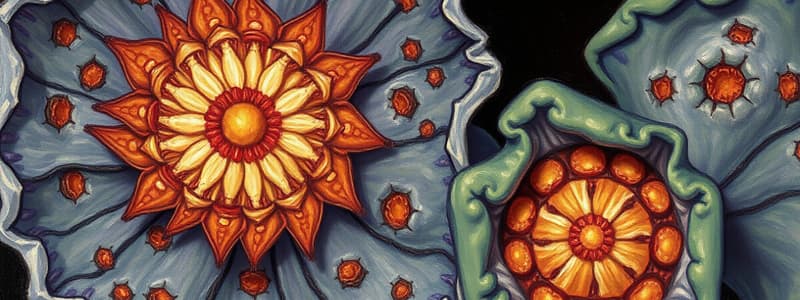Podcast
Questions and Answers
What adaptation allows vascular tissue to effectively transport water?
What adaptation allows vascular tissue to effectively transport water?
- Myelin insulation for faster transport.
- Presence of chlorophyll for photosynthesis.
- Xylem walls strengthened with lignin. (correct)
- Waxy cuticle to reduce water loss.
Which of the following correctly describes tissue culture?
Which of the following correctly describes tissue culture?
- Growth of cells outside of an organism on a nutrient medium. (correct)
- The study of reactions within living tissues.
- Harvesting organs directly from living creatures.
- The process of growing entire organisms.
Which tissue is mainly responsible for movement in animals?
Which tissue is mainly responsible for movement in animals?
- Epithelial tissue.
- Muscle tissue. (correct)
- Nervous tissue.
- Connective tissue.
What is the primary function of dermal tissue in plants?
What is the primary function of dermal tissue in plants?
Which example is not a characteristic function of nervous tissue?
Which example is not a characteristic function of nervous tissue?
Which organ system is primarily involved in processing sensory information?
Which organ system is primarily involved in processing sensory information?
What is the major requirement for maintaining tissue culture effectively?
What is the major requirement for maintaining tissue culture effectively?
Which type of tissue would be involved in the construction of protective barriers in plants?
Which type of tissue would be involved in the construction of protective barriers in plants?
What is the function of myelin in nervous tissue?
What is the function of myelin in nervous tissue?
What role do myosin and actin play in muscle tissue?
What role do myosin and actin play in muscle tissue?
Which of the following best describes dermal tissue in plants?
Which of the following best describes dermal tissue in plants?
What is considered an essential component of organizing cells into tissues?
What is considered an essential component of organizing cells into tissues?
What type of adaptation is characteristic of vascular tissue?
What type of adaptation is characteristic of vascular tissue?
Which tissue type is primarily involved in transmitting signals in the body?
Which tissue type is primarily involved in transmitting signals in the body?
What distinguishes an organ system from organs and tissues?
What distinguishes an organ system from organs and tissues?
Which factor is crucial for the success of tissue culture?
Which factor is crucial for the success of tissue culture?
What role does the heart serve in the context of animal organs?
What role does the heart serve in the context of animal organs?
Which of the following is NOT a characteristic of tissue culture?
Which of the following is NOT a characteristic of tissue culture?
Study Notes
Cell and Tissues
- Cells are the fundamental unit of life and the smallest structures exhibiting life characteristics.
- Tissues consist of groups of similar cells collaborating to perform a specific function.
Types of Tissues
- Plant tissues include dermal tissue and vascular tissue.
- Dermal tissue features a waxy cuticle, serving as a barrier against microbial invasion.
- Vascular tissue has adapted with xylem walls reinforced with lignin for structural support.
- Animal tissues include muscle tissue and nervous tissue.
- Muscle tissue is equipped with myosin and actin filaments that facilitate contractions.
- Nervous tissue is insulated with myelin, which enhances signal transmission speed.
Organs
- An organ is a collection of similar tissues working in unison to perform a specific function.
- Examples of plant organs are the leaf and stem.
- An example of an animal organ is the heart.
Organ Systems
- An organ system consists of a group of compatible organs functioning together.
- An example of an animal organ system is the nervous system.
Tissue Culture
- Tissue culture refers to the growth of cells externally, typically on a nutrient-rich medium.
- Applications of tissue culture include cancer research and producing human tissue for organ transplants.
- Tissue culture requires appropriate conditions including a suitable temperature and essential nutrients for cell growth.
Fundamental Biological Structures
- A cell is the basic unit of life, representing the smallest structure capable of exhibiting all characteristics of living organisms.
- Tissues consist of groups of similar cells collaborating to perform specific functions.
Types of Tissues
-
Plant Tissues
- Dermal tissue: Protects the plant and has a waxy cuticle that prevents microbial entry.
- Vascular tissue: Transports water, nutrients, and food, with xylem walls reinforced by lignin for support.
-
Animal Tissues
- Muscle tissue: Contains myosin and actin filaments, enabling muscle contractions for movement.
- Nervous tissue: Comprises neurons insulated with myelin, facilitating rapid signal transmission.
Organs and Organ Systems
-
An organ is formed when multiple tissue types collaborate to perform a specific function.
-
Examples of plant organs include the leaf and stem.
-
The heart serves as a key example of an animal organ.
-
Organ systems consist of groups of organs that work together to perform coordinated functions.
-
The nervous system is a prominent example of an animal organ system.
Tissue Culture
- Tissue culture involves cultivating cells outside their natural environment on a nutrient medium.
- It is instrumental in cancer research, among other applications.
- Maintaining a suitable temperature is a critical requirement for successful tissue culture.
Studying That Suits You
Use AI to generate personalized quizzes and flashcards to suit your learning preferences.
Description
Explore the fundamental units of life through this quiz on cells and tissues. Understand the various types of plant and animal tissues, their functions, and how they form organs and organ systems. Test your knowledge on the key characteristics and roles of these biological structures.



